Table of Contents
Verbs are one of the most critical parts of speech in English grammar. They express actions, states, and conditions. To master English, it’s essential to understand the different types of verbs, their uses, and how they compare to one another. In this article, we’ll discuss all the major types of verbs, along with clear explanations and comparisons where necessary.
What is a Verb?
A verb is a word that is used to express an action, occurrence, or state of being.
Verbs in Sentences:
She writes stories every weekend. (action)
He feels happy today. (state of being)
The meeting starts at 10 AM. (occurrence)
Types of Verb
- Action Verbs
- Linking Verbs
- Helping Verbs (Auxiliary Verbs)
- Modal Verbs
- Transitive Verbs
- Intransitive Verbs
- Stative Verbs
- Regular Verbs
- Irregular Verbs
- Phrasal Verbs
1. Action Verbs
Action verbs describe something that the subject is doing. They can refer to physical actions such as run, jump, or swim, as well as mental actions like “think” and “decide.”
How to Identify:
To find the action verb in a sentence, ask what the subject is doing.
- He runs fast.
- She thinks about her future.
2. Linking Verbs
Linking verbs do not express actions but connect the subject of a sentence to more information about the subject.
The most common linking verb is “to be” (am, is, are, was, were). Other linking verbs include seem, become, and appear.
How to Identify:
Linking verbs are followed by either an adjective or a noun that describes or identifies the subject.
- She is a doctor.
- The sky looks clear today.
3. Helping Verbs (Auxiliary Verbs)
Helping verbs assist the main verb in forming different tenses, moods, and voices. Common helping verbs include is, have, do, will, and should.
How to Identify:
Helping verbs come before the main verb and modify its meaning.
- She is running a marathon.
- They have finished their homework.
4. Modal Verbs
Modal verbs are a type of helping verb that express possibility, permission, ability, or necessity.
Common modal verbs include can, could, may, might, will, shall, should, must.
How to Identify:
Modals always appear before the base form of the main verb.
- She can sing beautifully.
- You should follow the rules.
5. Transitive Verbs
Transitive verbs require a direct object to complete their meaning. The object is the thing or person that receives the action.
How to Identify:
To find a transitive verb, ask What? or Whom? after the verb.
- She threw the ball. (The ball is the direct object.)
- He reads books. (Books is the direct object.)
6. Intransitive Verbs
Intransitive verbs do not require a direct object. They express actions that do not affect an object or person directly.
How to Identify:
Intransitive verbs can stand alone without needing an object.
- She laughed loudly.
- The baby cried for hours.
7. Stative Verbs
Stative verbs describe states or conditions rather than actions. They often relate to thoughts, emotions, possession, or senses.
Common stative verbs include know, believe, love, hate, own, and seem.
How to Identify:
These verbs describe what someone feels or knows, rather than what they are doing.
- I know the answer.
- She owns a car.
8. Regular Verbs
Regular verbs follow a predictable pattern when forming the past tense, typically by adding “-ed” or “-d” to the base form.
How to Identify:
If a verb adds “-ed” or “-d” to form its past tense, it’s regular.
- Present: Talk → Past: “Talked.”
- Present: Dance → Past: “Danced.”
9. Irregular Verbs
Irregular verbs do not follow a consistent pattern when forming their past tense or past participles. These verbs have unique forms for their past tenses.
How to Identify:
Irregular verbs must be memorized as they do not follow standard rules.
- Present: Go → Past: Went.
- Present: Bring” → Past: Brought.
10. Phrasal Verbs
Phrasal verbs are combinations of a verb and a preposition or adverb that, together, create a new meaning different from the individual words.
How to Identify:
The meaning of the entire phrase changes when the verb and preposition are combined.
- Give up means to quit.
- Run into means to meet by chance.
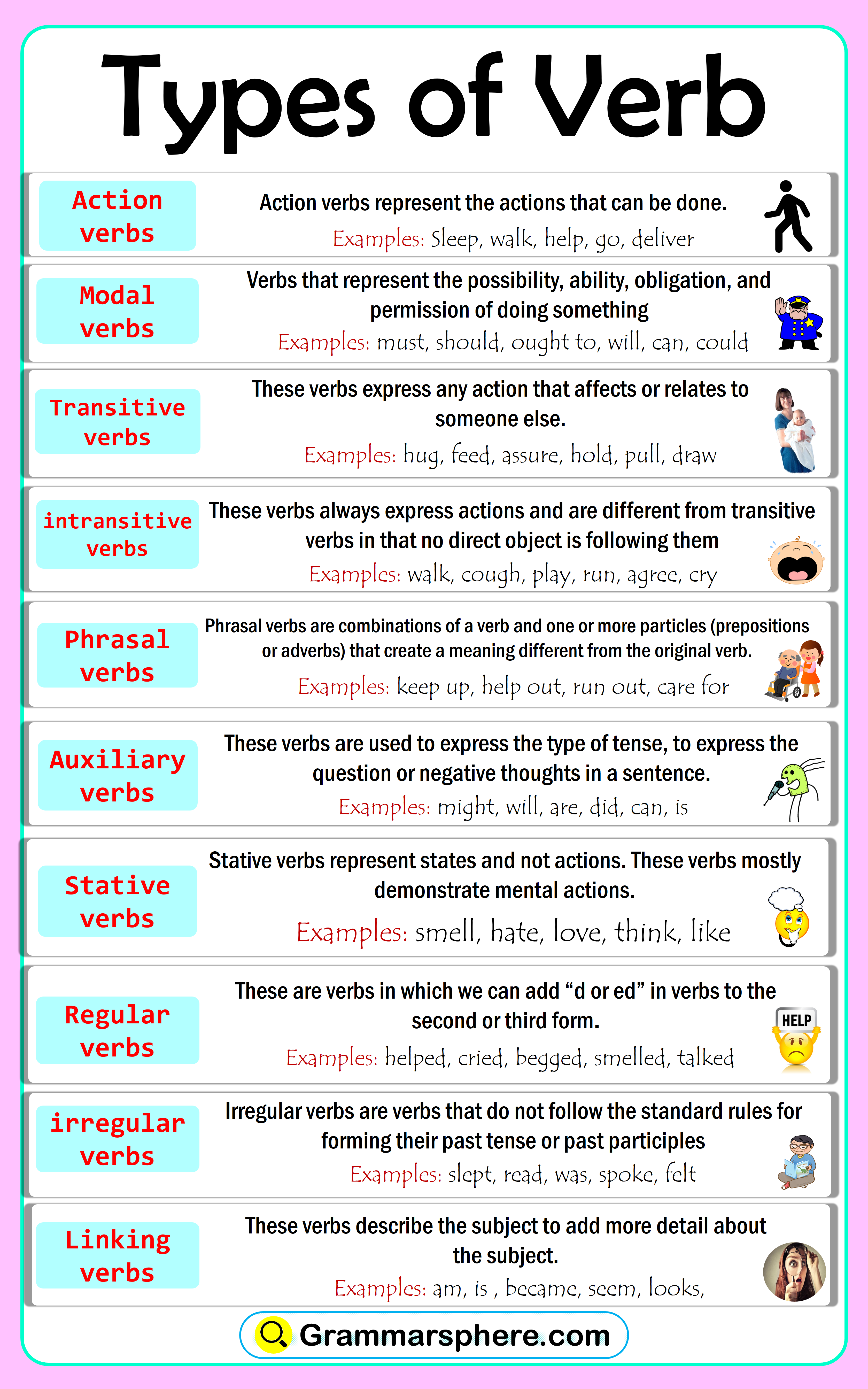
Verb Conjugation
Verb conjugation refers to the process of changing a verb form to provide information about various grammatical aspects such as tense, mood, voice, aspect, person, number, or gender.
This change helps convey when an action occurs, whether it’s ongoing or completed, and who is performing the action.
For instance, the verb to write can be conjugated in different tenses:
- Base Form: write
- Past Simple: wrote
- Present Simple: write
- Future Simple: will write
Tenses Overview
| Aspect | Past | Present | Future |
|---|---|---|---|
| Simple | I wrote a letter. | I write a letter. | I will write a letter. |
| Progressive | I was writing a letter. | I am writing a letter. | I will be writing a letter. |
| Perfect | I had written a letter. | I have written a letter. | I will have written a letter. |
| Perfect Progressive | I had been writing a letter. | I have been writing a letter. | I will have been writing a letter. |
Guide to English Verb Tenses
Simple Tense:
Past Tense
Describes a completed action.
- I wrote a letter.
Present Tense
Describes a habitual action or general truth.
- I write a letter.
Future Tense
Used to talk about actions or events that will happen later.
- I will write a letter.
Progressive Tense
Past Progressive
Describes an action that was ongoing at a specific time in the past.
- I was writing a letter.
Present Progressive
Describes an action that is currently in progress.
- I am writing a letter.
Future Progressive
Describes an action that will be ongoing at a specific time in the future.
- I will be writing a letter.
Perfect Tense
Past Perfect
Describes an action completed before another past action.
- I had written a letter.
Present Perfect
Describes an action that started in the past and has relevance to the present.
- I have written a letter.
Future Perfect
Describes an action that will be completed before a specific future time.
- I will have written a letter.
Perfect Progressive Tense
Past Perfect Progressive
Describes an ongoing action that occurred before another past action.
- I had been writing a letter.
Present Perfect Progressive
Describes an ongoing action that started in the past and continues into the present.
- I have been writing a letter.
Future Perfect Progressive
Describes an ongoing action that will continue up to a specific point in the future.
- I will have been writing a letter.
Types of Verbs Based on Meaning
Verbs Referring to Experiences or Feelings
These verbs express actions or states related to personal experiences, emotions, or sensations. They often convey how someone feels or what they perceive.
Examples:
- Feel – I feel happy today. (Indicates an emotional state.)
- Enjoy – They enjoy going to the beach. (Expresses a positive experience.)
- Love – She loves reading books. (Describes a strong positive feeling towards an activity.)
- Hate – He hates waiting in long lines. (Conveys a strong negative feeling.)
- Prefer – I prefer tea over coffee. (Indicates a choice based on personal experience.)
- Suffer – She suffers from anxiety. (Describes a negative emotional or physical state.)
- Miss – I miss my friends from college. (Indicates a feeling of longing for someone or something.)
- Worry – He worries about his health. (Expresses concern regarding a specific issue.)
- Excite – The news excited her. (Conveys a strong emotional response.)
- Bore – The lecture bored him. (Indicates a lack of interest or engagement.)
Verbs Referring to a State or Condition
These verbs describe a state of being, appearance, or possession rather than an action.
Examples:
- Be – He is a doctor. (Indicates a state of being.)
- Have – They have a beautiful house. (Expresses possession.)
- Seem – She seems tired today. (Describes a condition or appearance.)
- Become – He became a successful entrepreneur. (Indicates a change in state.)
- Remain – They remain friends despite the distance. (Describes a continuous state.)
- Belong – This book belongs to her. (Indicates possession or association.)
- Lack – They lack the necessary resources. (Describes a deficiency or absence.)
- Contain – The box contains old photographs. (Expresses what is held within something.)
- Include – The package includes a user manual. (Indicates what is part of a whole.)
- Depend – Success depends on hard work. (Describes a condition based on another factor.)
Stative and Dynamic Verbs
Stative Verbs
These verbs Describe a state or condition. They show feelings, thoughts, or situations that don’t change. We usually don’t use them in continuous tenses (like “is” or “are”).
Dynamic Verbs
These Verbs describe actions or activities. They show things that happen or can be done. We can use them in continuous tenses.
Examples of Stative vs. Dynamic Verbs
Knowing vs. Learning
- Stative Verb: She knows the answer. (This means she has knowledge.)
- Dynamic Verb: She is learning the answer. (This means she is currently in the process of learning.)
Loving vs. Enjoying
- Stative Verb: I love chocolate. (This means I have a strong feeling for chocolate.)
- Dynamic Verb: I am enjoying this chocolate cake. (This means I am currently having a good time with the cake.)
Having vs. Experiencing
- Dynamic Verb: He is having a great time at the party. (This means he is currently enjoying himself at the party.)
- Stative Verb: He has a car. (This means he owns a car.)
FAQS
What is a verb and examples?
A verb is a word that expresses an action, state, or occurrence in a sentence.
Action verbs: run, write, eat (e.g., She runs every morning.)
State verbs: be, know, believe (e.g., He is happy.)
Helping verbs: has, will, do (e.g., She will call you later.)
What are 10 Examples of Verb?
Run – She runs every morning.
Eat – They eat lunch at noon.
Write – He writes a book.
Speak – She speaks three languages.
Jump – The kids jump on the trampoline.
Sing – He sings beautifully.
Think – I think it will rain today.
Know – She knows the answer.
Watch – We watch movies on weekends.
Have – They have a big house.
What is a verb and Types?
A verb is a word that expresses an action, occurrence, or state of being in a sentence.
Verbs are categorized into different types, including action verbs, linking verbs, auxiliary (helping) verbs, modal verbs, transitive verbs, intransitive verbs, and stative verbs.
What Are Three Types of Verbs with Examples?
Action Verbs: Express physical or mental actions.
Example: She runs every morning.
Linking Verbs: Connect the subject to a state or condition.
Example: He is very tired after work.
Helping (Auxiliary) Verbs: Assist the main verb to form tenses or moods.
Example: They have finished their homework.
You May Also Like

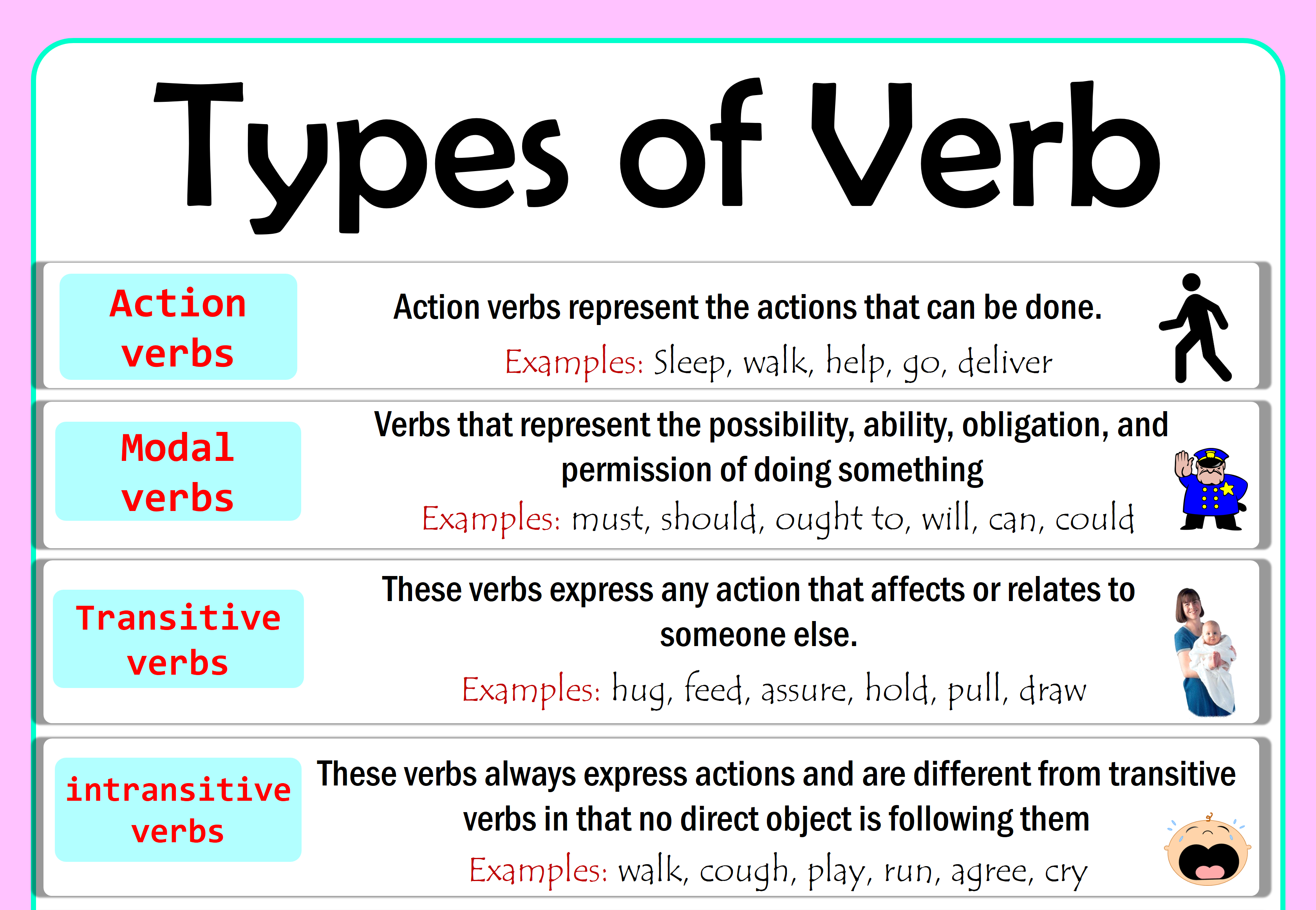
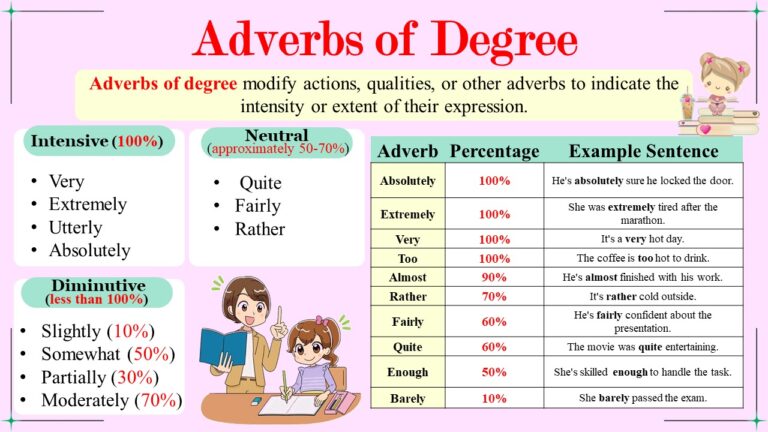
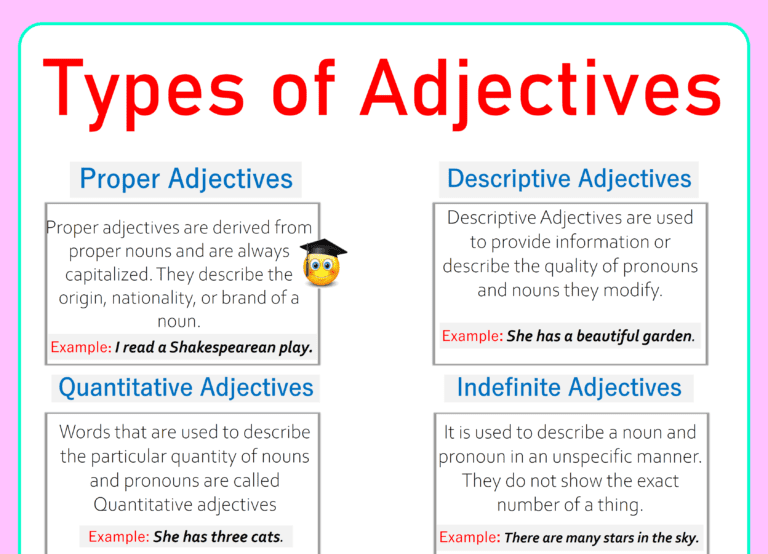
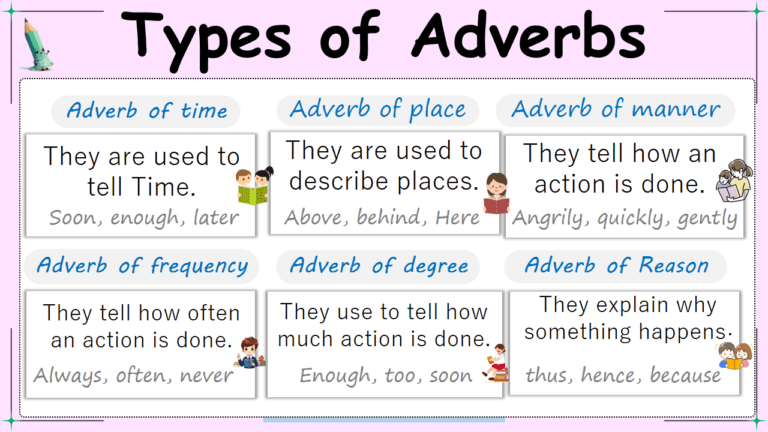

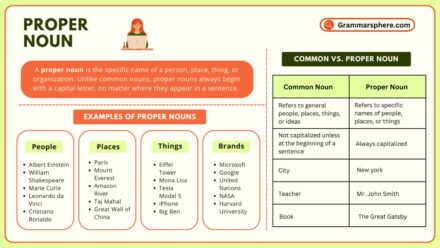
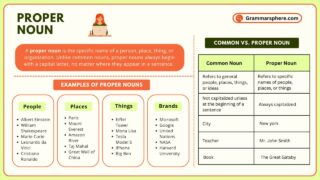
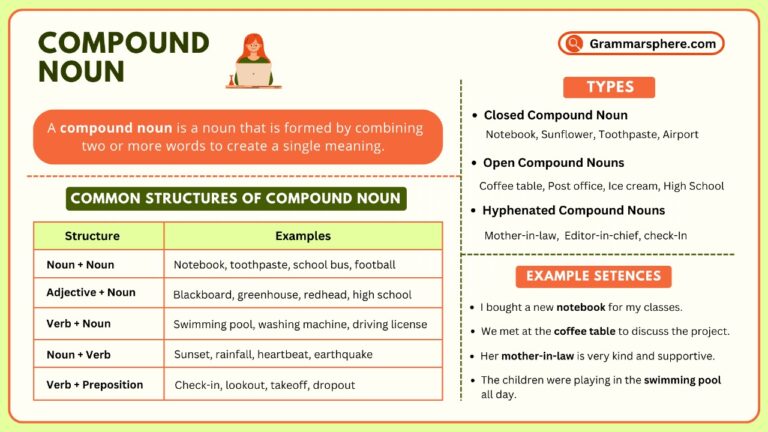
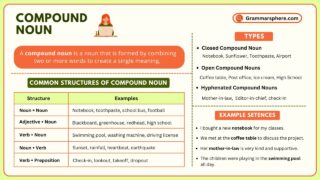
Leave a Comment